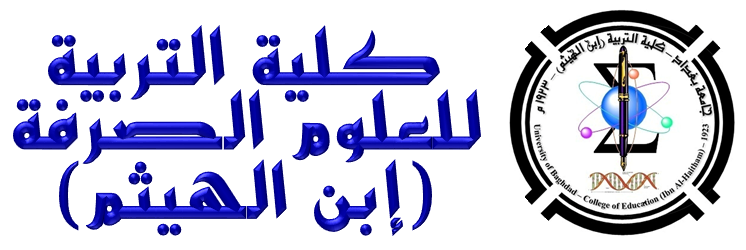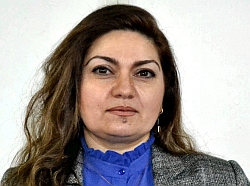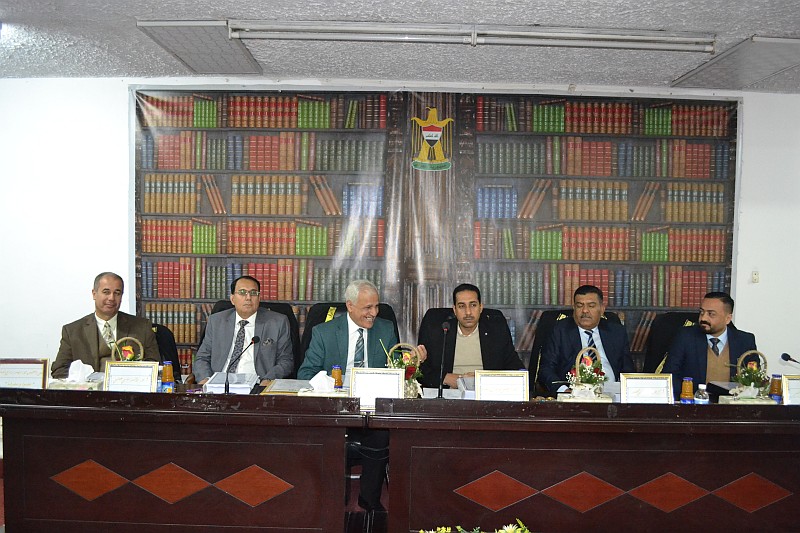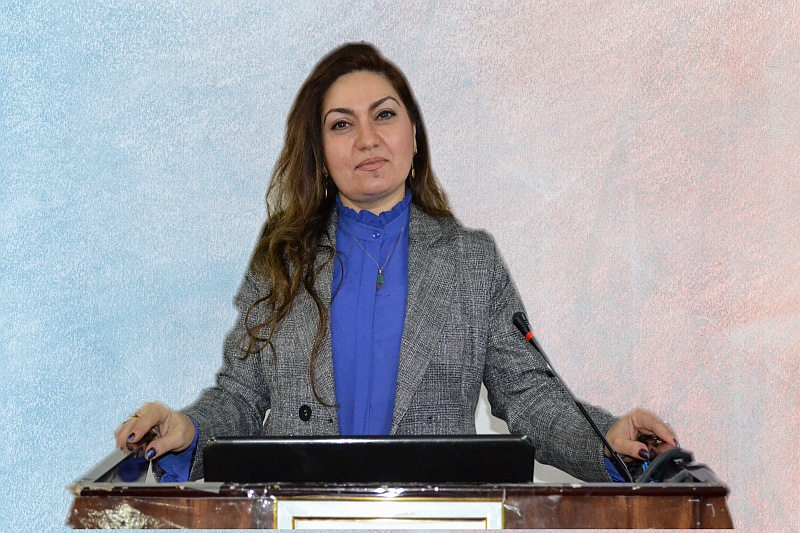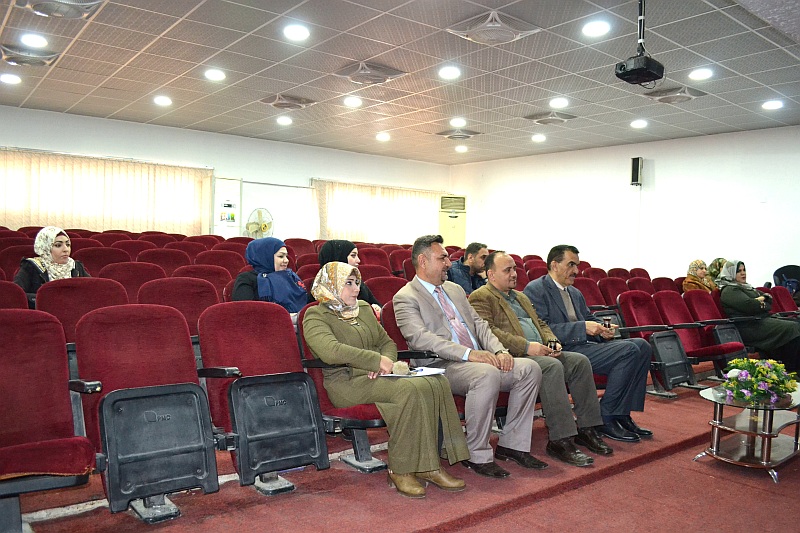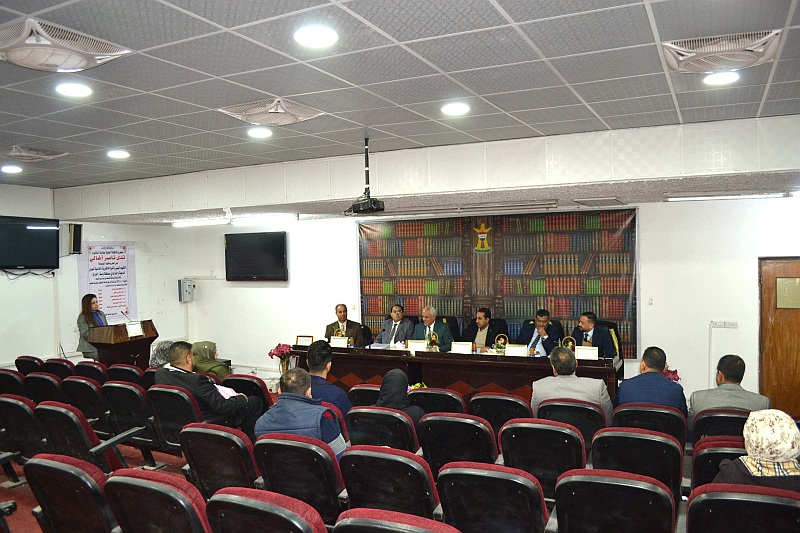جرت على قاعة المرحوم الدكتور سالم عبدالحميد المناقشة العلنية لاطروحة طالبة الدكتوراه ندى ناصر آغالي ميرزا من قسم علوم الحياة الموسومة :
التقييم البيئي وتنوع اللافقريات القاعية لنهري الدجيلة والغراف في محافظة واسط/ العراق
وتألفت لجنة المناقشة من التدريسيين الأفاضل :
ا.د. ابراهيم مهدي عزوز رئيسا
ا.د. رائد سامي عاتي عضوا
ا.م.د. مرتضى يوسف مهدي عضوا
ا.م.د. احمد جاسم محمد عضوا
ا.م.د. احمد جميل محمد عضوا
ر. ب. د. مهند رمزي نشأت عضوا ومشرفا
أجريت الدراسة الحالية على فرعين رئيسين من فروع نهر دجلة وهما نهري الدجيلة والغراف عند سدة الكوت ضمن محافظة واسط. هدفت الدراسة التعرف على ابرز الخصائص الفيزائية والكيميائية لمياه النهرين واثرهما في كمية ونوعية لافقريات القاع لكلا النهرين علاوة على تقييم التنوع الاحيائي فيهما باعتماد أدلة التنوع الاحيائي. وبذلك تعد الدراسة بيئية شاملة لتقييم تنوع مجتمع اللافقريات القاعية في مياه النهرين.
جمعت عينات شهرية عشوائية من المياه والطمى والاحياء اللافقرية القاعية لمدة 12 شهراً ابتداءً من كانون الثاني ولغاية كانون الأول 2016، تم خلالها اختيار خمس محطات على كل نهر توزعت على مسافة 10± كم بينهما وضمن محافظة واسط.
تضمنت الدراسة الحالية قياس 21 عاملاً بيئياً محدداً في تنوع اللافقريات القاعية التي شملت درجة حرارة الهواء والماء والكدرة والأس الهيدروجيني والتوصيلية الكهربائية والملوحة والمواد الصلبة الذائبة الكلية والعالقة الكلية والاوكسجين المذاب والنسبة المئوية للاشباع بالاوكسجين والمتطلب الحيوي للاوكسجين والعسرة الكلية والكالسيوم والمغنيسيوم والقاعدية الكلية والكبريتات والبيكاربونات والنترات والفوسفات الفعالة ونسجة التربة وكمية المادة العضوية فيها.
كما شملت دراستنا جوانب حياتية تمثلت بحساب الكثافة الكلية Total Density والوفرة النسبية Relative Abundance (Ra) ودليل الثباتية Constancy Index (S) ودليل الغزارة Species Richness Index (D) ودليل شانون- ونتر Shanon- Weiner Diversity Index (H) ودليل تجانس ظهور الانواع Species Uniformity Index (E) ودليل جاكارد للتشابه Jaccard Presence- Community لتوضيح درجة التشابه ما بين المحطات في التكوين النوعي والكمي للافقريات القاع المدروسة.
اشارت نتائج الدراسة الى تأثر درجة حرارة مياه النهرين بدرجة حرارة الجو المحيط وتراوحت بين 12.5م-30.2م في نهر الدجيلة و13.3م-30.6م في نهر الغراف وتراوحت قيم الاس الهيدروجيني التي كانت باتجاه القاعدية الخفيفة بين 8.5-6.8 في الدجيلة و9.8-7.1 في الغراف. وتبين ان قيم الاوكسجين المذاب والنسبة المئوية للاشباع بالأوكسجين تتراوح بين 16.6-3.6 ملغم/لتر وبنسبة %127.02-23.25 في نهر الدجيلة في حين بلغت ما بين 13-4 ملغم/لتر وبنسبة اشباع بالاوكسجين ما بين %127.52-44.49 في نهر الغراف، إذ وصلت الى قيم تحت الحرجة في نهر الدجيلة.
كما اظهرت النتائج ارتفاع قيم المتطلب الحيوي للاوكسجين BOD5 في بعض نماذج مياه النهرين التي تراوحت بين 7.5-1 ملغم/لتر و6.8-0.4 ملغم/لتر في الدجيلة والغراف على التوالي، وبذلك تعد مياه النهرين مشكوكاً في نظافتهما. وجد ان مياه النهرين عكرة اذ كانت قيم الكدرة للنهرين تتراوح ما بين 116-2.36 و101-4.2 NTU للدجيلة والغراف، وقيم القاعدية الكلية ما بين 427-30.5 ملغم/لتر و384-183 ملغم/لتر وعلى التوالي. كما وجد ان مياه النهرين هي مياه مويلحة Oligohaline فقد ترواحت مديات قيم التوصيلية الكهربائية والملوحة ما بين 1220-370 مايكروسيمنيز/سم و%o0.78-0.23 في نهر الدجيلة و1070-480 مايكروسيمنيز/سم و%o0.68-0.30 في نهر الغراف، في حين بلغت قيم المواد الصلبة الذائبة الكلية TDS والعالقة الكلية TSS بين 0.61-0.2 غم/لتر و171-1 ملغم/لتر، 0.97-0.41 غم/لتر و121-10 ملغم/لتر في الدجيلة والغراف على التوالي. وتعد مياه النهرين عسرة اذ تراوحت قيم العسرة الكلية ما بين 540-316 ملغم/لتر و580-312 ملغم/لتر وعلى التوالي اما البيكاربونات فقد سجلت تراكيزاً ما بين 180-120 ملغم/لتر و185-62 ملغم/لتر في النهرين. وسجلت تراكيز ايونات الكالسيوم والمغنيسيوم اذ تغلبت تراكيز الكالسيوم على تراكيز المغنيسيوم في كلا النهرين وقد تراوحت بين 160.37-60.12 ملغم/لتر للكالسيوم و93.4-14.49 ملغم/لتر للمغنيسيوم في نهر الدجيلة وما بين 160.32-76.15 ملغم/لتر للكالسيوم و68.15-2.29 ملغم/لتر للمغنيسيوم في الغراف. في حين تراوحت تراكيز ايونات الكبريتات بين 150-40 ملغم/لتر و240-50 ملغم/لتر في النهرين وعلى التوالي.
اما المغذيات المتمثلة بالنترات والفوسفات فقد اظهرت النتائج ان تراكيزها تراوحت ما بين 2.5-0.78 ملغم/لتر للنترات و0.08-0.01 ملغم/لتر للفوسفات في الدجيلة، في حين تراوحت بين 2.85-0.001 ملغم/لتر للنترات و0.39-0.019 ملغم/لتر للفوسفات في مياه الغراف.
وسجل طمى نهر الدجيلة نسبة اعلى للمادة العضوية عن المسجلة في طمى نهر الغراف، إذ تراوحت ما بين %12.68-2.43 في نهر الدجيلة وما بين %6.9-2.3 في نهر الغراف. وبينت نتائج نسجة القاع وحجم الدقائق الرسوبية لكل من الطين والغرين والرمل ان ادنى النسب المئوية كانت %25 و%37.8 و%14.54 واعلاها كانت %37 و%48.46 و%34.14 لقاع نهر الدجيلة في حين بلغت ادنى النسب %32.2 و%41.4 و%8.82 واعلاها %37 و%58.98 و%25.6 في قاع نهر الغراف.
اظهرت نتائج الدراسة الاحيائية تواجد 76 وحدة تصنيفية في نهر الدجيلة و63 وحدة تصنيفية في نهر الغراف من اللافقريات القاعية منها 11 وحدة تصنيفية كتسجيل جديد لاول مرة في العراق ووحدة تصنيفية واحدة كتسجيل جديد في نهر الدجيلة، توزع ظهورها ما بين 25 و23 وحدة من الديدان الحلقية و25 و15 وحدة من المفصليات و21 و20 وحدة من النواعم في النهرين على التوالي و5 وحدات تصنيفية من الديدان الخيطية في كل نهر وبنسب مئوية قدرها 27 و%17 للديدان الحلقية و12 و%9 للمفصليات و58 و%73 للنواعم و3 و%1 للديدان الخيطية وعلى التوالي.
اما الكثافة السكانية الكلية للافقريات القاع في النهرين فقد كان المعدل السنوي لنهري الدجيلة 2120.92 فرد/م3 و909.27 فرد/م3 لنهر الغراف. في حين كان المعدل السنوي للكثافة الكلية للديدان الحلقية 369.94 فر/م3 و183.18 فرد/م3 وللمفصليات 266.76 فرد/م3 و55.78 فرد/م3 وللنواعم 1440.09 فرد/م3 و686.34 فرد/م3 وللديدان الخيطية 71.62 فرد/م3 و10.13 فرد/م3 وعلى التوالي وكانت الكثافة السكانية والنسب المئوية لتواجد صنف النواعم هي الاعلى على غير العادة تلتها الديدان الحلقية ومن ثم المفصليات واخيراً الديدان الخيطية لكلا النهرين.
بينت نتائج مؤشر الوفرة النسبية Relative Abundance Index (Ra) للديدان الحلقية ان الانواع Branchiura sowerbyi وLimmnodrilus hoffmesiter وLimnodrilus profundicola وLimnodrilus udekemianus وEiseniella tetraedra وOligocheacta coccun قد اشتركت بكونها الاكثر وفرة في نهري الدجيلة والغراف في حين كانت الانواع Potamothrix hammoniensis وParanais litoralis وEnchytracus sp. هي الاكثر وفرة في نهر الغراف والانواع Pristina plumaseta وLimnodrilus claparedeanus في نهر الدجيلة.
اما المفصليات فقد اشتركت الانواع Paralauterborniella sp. وOstracoda وDicrotendipes Lucifer وOrthrocladius dubitus وCryptochironomus sp. وPolypedilum scalaenum وChironomid pupa بكونها الاكثر وفرة في قاع النهري في حين كانت الانواع Polypedilum aviceps وEinfeldia natchitocheae وGlyptotendipes paripes وDicrotendipes leucoscelis وDicrotendipes thanatogratus وChironomus melansecnce هي الاكثر وفرة في الدجيلة والانواع Chironomus piger وعائلة Crangonyctidae وParachironomus sublettei وOrthrocladius thienemanni وEpoicocladius sp. وHarnishia complex في قاع الغراف.
وكانت للانواع Melanoid tuberculata وPhysa acuta وPisidium dubium وMelanopsis nodosa وLymnaea auricularia وCorbicula fluminalis في صنف النواعم الوفرة الاكثر في قاع النهرين في حين اظهر النوع Corbicula fluminea الوفرة الاكثر في نهر الدجيلة والنوع Gyraulus intermixtus في نهر الغراف.
واشتركت اربعة انواع من الديدان الخيطية المسجلة في هذه الدراسة في وفرتها الاعلى في قاع النهري وهي Seinura sp. وActinolaimus sp. وDorylaimus fecundus وDolichodorus heterocephalus في حين كان النوع الخامس Alaimus simplex الاكثر وفرة في نهر الغراف فقط.
ووفقاً لدليل الثباتية Constancy Index (S) فان الانواع C. fluminalis
وC. fluminea وM. tuberculata وM. nodosa وL. auricularia وPhysa acuta وNeritina schlaeflii وOstracoda وSeinura sp. هي الاكثر تكراراً وظهوراً وهي بذلك تعد انواعاً ثابتة في بيئة نهر الدجيلة اما نهر الغراف فقد بينت النتائج ان مجموعة النواعم متمثلة بالانواع C. fluminalis وM. tuberculata وM. nodosa وTheodoxus jordani وL. auricularia وPhysa acuta كانت هي الاكثر ثباتاً وتكراراً وظهوراً.
سجلت اعلى قيم لغزارة الانوع Species Richness في بيئة نهري الدجيلة والغراف وكانت 0.06 و0.727 للديدان الحلقية و0.06 للمفصليات في النهرين و0.0378 و0.0454 للنواعم و0.0455 و0.0303 للديدان الخيطية وعلى التوالي في حين تمثلت القيم الادنى بعدم الظهور ولكلا النهرين.
اما نتائج دليل جاكارد للتشابه Jaccard presence- community فقد بينت ان اقوى نسبة تشابه لمجاميع اللافقريات القاعية كانت بين المحطتين 2 و4 وبنسبة %69.39 في نهر الدجيلة في حين كانت اقوى نسبة تشابه بين المحطتين 3 و5 وبنسبة %52.08 في نهر الغراف.
اما اعلى قيمة لدليل شانون- وينر Shanon- weiner diversity Index (H) للتنوع الكلي للافقريات قاع نهر الدجيلة فقد بلغت 2.910 بت/فرد في حين بلغت 2.428 بت/فرد في نهر الغراف. وتمثلت ادنى القيم بعدم الظهور في نهر الغراف و0.408 بت/فرد في نهر الدجيلة.
في حين اشار دليل تجانس ظهور الانواع Species uniformity index (E) الى ان اعلى قيمة تجانس لنهر الدجيلة بلغت 1.17 و1.04 لنهر الغراف في حين تمثلت ادنى قيمة بعدم الظهور في نهر الغراف و0.26 في نهر الدجيلة.
